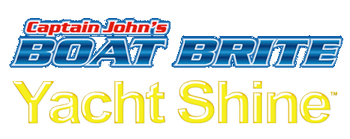EPA National Clean Marina Guidelines
EPA National Clean Marina Guidelines
The Clean Marina Initiative is a voluntary, incentive-based program promoted by NOAA and others that encourages marina operators and recreational boaters to protect coastal water quality by engaging in environmentally sound operating and maintenance procedures.
CLEANING PRODUCTS FOR BOATS...
Many of the products that we use in our homes are perfectly safe in that environment. On our boats, however, where cleaners are rinsed directly into the water without any treatment, the same cleaners can be lethal to marine life.
Captain John's Boat Brite ultimate cleaners offer YOU, the boating public a choice. Our cleaners are 100% non-toxic and phosphate-free and of course biodegradable.
AND THEY REALLY WORK WELL!!!!
Grease-cutting detergents, scouring powders and bleaches containing chlorine, ammonia and acids are extremely toxic to marine organisms. And many of the cleaners we find at our marinas and boat supply stores contain the same ingredients. If the label say's, "DO NOT GET INTO EYES", "HARMFUL IF SWALLOWED", "AVOID SKIN CONTACT" or any "WARNING", it's going to do damage to marine life, and to YOUR life.
When purchasing cleaners for your boat look for the words "non-toxic" and "phosphate-free" on the label.
"BIODEGRADABLE" sounds good but it doesn't mean that the product is non-toxic. Often, by the time a toxic chemical has "biodegraded" the damage to OUR waterways and to OURSELVES has been done.
"consider this... Most boats are cleaned weekly, some more,some less, but usually every week. We spray down the deck,or do a liberal pour into a bucket of our favorite cleaner,and proceed to clean. Then out comes the hose and off goes the dirt AND the cleaner you used - INTO THE WATER! If you're NOT using a cleaner that is NON-TOXIC AND PHOSPHATE-FREE, you've just contributed to the pollution of your favorite waterway. AND when you look around and see hundreds of boats at their dock or out on the water and if they are being cleaned the same way and if your season is several months long - well it's easy to see how our boating playgrounds can get pretty messed up.
Hey, it's your choice, but if the Captain John's Boat Brite ultimate cleaners work as well as the "HARMFUL" brands, make the switch like many boaters have already done. Several years ago the EPA introduced the "The National Clean Marina Program". This program was initially introduced to the "coastal waters" states but has grown substantially and now many states with closed Eco-system waterways have signed on. The National Clean Marina Program is available to all marinas in the participating states. The program is voluntary. The criteria for a marina to qualify as a "Clean Marina" is extensive and the marinas that have elected to become "Clean Marinas", and the patrons at these marinas are enjoying the results.
Best Boat Maintenance Practices
REMEMBER...
- Clean water starts with good boat cleaning and maintenance methods.
- Good stewardship of our boating water is about making choices.
WHAT BOATERS CAN DO
- Read labels and buy products that will do the job without harming people and the water.
- Think about where the all the dirt, paint chips, and solvents could go; chose a method which reduces the chance of getting any in the water.
- Do as much hull work inside or under cover where rain can't wash dust, dirt, paint chips, oil and solvents to the water.
- Help other boaters understand cleaner ways to do boat maintenance; pass this fact sheet on.
BOAT CLEANING
- Look at product labels and buy 'non-toxic' and 'phosphate-free' cleaners while 'biodegradable' sounds good, it doesn't mean it is 'non-toxic'; avoid those which warn 'do not get in eyes' or 'always wear gloves' since these can harm the environment.
- Use alternative cleaners, such as baking soda, lemon juice, vinegar, and elbow grease; avoid those with bleach, ammonia, lye, or petroleum distillates.
- Wash decks and hulls frequently with fresh water; using a little cleaner goes a long way; more cleaner does not necessarily work better, but can be harmful.
- Buy only as much cleaner as you need to avoid the need to dispose of leftover cleaning supplies.
- Clean boat bottoms ashore, over hard surfaces or a tarp, where all debris can be contained.
- Keep caps on bottles while cleaning; and open container might spill into the water.
- Follow the label recommendation and local regulations for proper disposal.
- Recycle the product containers.
ENGINE MAINTENANCE
- Tune your engine regularly per manufacturer's recommendation; this helps your engine operate cleanly and more efficiently.
- Frequently inspect fuel lines for leaks or potential leaks such as cracks, loose connections; repair as necessary.
- Change oil and transmission fluid with a spill proof pump or vacuum tank; slip a plastic bag over the oil filter before removal; wipe up oil drops immediately with absorption pad.
- Use orange-pink colored propylene antifreeze/coolant which is less toxic, vs blue-green colored ethylene glycol which is very toxic and kills animals that ingest it.
- Use minimal engine cleaning solvents; frequently wipe engine to keep clean; engine parts should be cleaned on land over a leak-free container, not over the water.
- Keep separate and recycle used oil, solvents an antifreeze; or follow label instructions or local regulations for disposal.
SANDING & PAINTING
- Do all hull scraping, sanding and chemical stripping ashore over a drop cloth to catch all debris.
- Prepare the surface with dustless sanders and vacuum to keep you, the air, ground, other boats clean.
- Use only legal bottom paint; depending on boat use, consider a hard non-ablative, paint which may be longer lasting.
- Leave paint cans open to thoroughly dry before throwing away.
